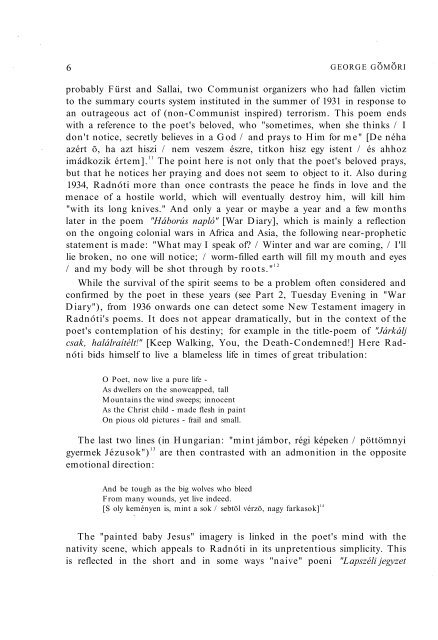HUNGARIAN STUDIES 11. No. 1. Nemzetközi Magyar ... - EPA
HUNGARIAN STUDIES 11. No. 1. Nemzetközi Magyar ... - EPA
HUNGARIAN STUDIES 11. No. 1. Nemzetközi Magyar ... - EPA
- No tags were found...
Create successful ePaper yourself
Turn your PDF publications into a flip-book with our unique Google optimized e-Paper software.
6 GEORGE GÖMÖRIprobably Fürst and Sallai, two Communist organizers who had fallen victimto the summary courts system instituted in the summer of 1931 in response toan outrageous act of (non-Communist inspired) terrorism. This poem endswith a reference to the poet's beloved, who "sometimes, when she thinks / Idon't notice, secretly believes in a God / and prays to Him for me" [De néhaazért ő, ha azt hiszi / nem veszem észre, titkon hisz egy istent / és ahhozimádkozik értem]. 11The point here is not only that the poet's beloved prays,but that he notices her praying and does not seem to object to it. Also during1934, Radnóti more than once contrasts the peace he finds in love and themenace of a hostile world, which will eventually destroy him, will kill him"with its long knives." And only a year or maybe a year and a few monthslater in the poem "Háborús napló" [War Diary], which is mainly a reflectionon the ongoing colonial wars in Africa and Asia, the following near-propheticstatement is made: "What may I speak of? / Winter and war are coming, / I'lllie broken, no one will notice; / worm-filled earth will fill my mouth and eyes/ and my body will be shot through by roots." 12While the survival of the spirit seems to be a problem often considered andconfirmed by the poet in these years (see Part 2, Tuesday Evening in "WarDiary"), from 1936 onwards one can detect some New Testament imagery inRadnóti's poems. It does not appear dramatically, but in the context of thepoet's contemplation of his destiny; for example in the title-poem of "Járkáljcsak, halálraítélt!" [Keep Walking, You, the Death-Condemned!] Here Radnótibids himself to live a blameless life in times of great tribulation:O Poet, now live a pure life -As dwellers on the snowcapped, tallMountains the wind sweeps; innocentAs the Christ child - made flesh in paintOn pious old pictures - frail and small.The last two lines (in Hungarian: "mint jámbor, régi képeken / pöttömnyigyermek Jézusok") 13are then contrasted with an admonition in the oppositeemotional direction:And be tough as the big wolves who bleedFrom many wounds, yet live indeed.[S oly keményen is, mint a sok / sebtől vérző, nagy farkasok] 14The "painted baby Jesus" imagery is linked in the poet's mind with thenativity scene, which appeals to Radnóti in its unpretentious simplicity. Thisis reflected in the short and in some ways "naive" poeni "Lapszéli jegyzet
















